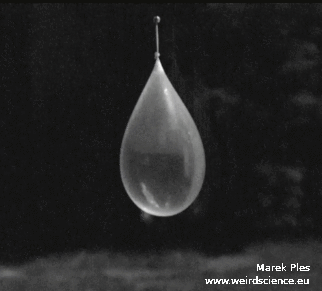Main
The fairest thing we can experience is the mysterious. It is the fundamental emotion which stands at the cradle of true art and science. He who knows it not and can no longer wonder, no longer feel amazement, is as good as dead, a snuffed-out candle.
Welcome!
Do you not agree with Einstein? In my opinion, his words express the truth about our world: it is wonderful, and we should strive to understand it as much as possible. Our reality is shaped by rules and laws, knowledge of which allows us to comprehend it. This is the purpose of science.

Unfortunately, recent events that have occurred, namely the unjustified aggression of Russia against Ukraine, compel us to reflect on the state of the surrounding reality. I, as the author of the 'WeirdScience' project, with a scientific approach to the world in mind, strive to maintain ideological neutrality in my work. However, in the face of the brutality of the Russian authorities and the savagery of their military - evidently also premeditatedly targeting civilians - I have decided to make an exception to this rule. The world of science condemns the actions of the Russians and calls for dialogue. The link below leads to an open letter addressed to the Russians, signed by, among others, Nobel laureates:
As far as I know, a similar letter to their own authorities has also been issued by some Russian scientists. Therefore, there is hope that Russian citizens who are not entangled in politics do not unconditionally support the attack on Ukraine and can, with their actions, help prevent bloodshed on both sides.
From the statistics of this website, I know that it is being read in Russia as well, both in its original version and with the use of automatic translation. Perhaps this message will also reach them.
We, citizens of Poland, will do everything we can to help our neighbors in need and be a support for them in these difficult times!
Natural sciences are often perceived as boring and difficult for the common person to understand. As in many areas of life, it also depends on our own point of view. Nowadays, the complexity and specialization growth make the entirety of knowledge in the field of natural sciences impossible for one person to comprehend. Humanism from the times of Leonardo da Vinci - when one person could be a specialist in all areas of knowledge - has unfortunately passed forever.
However, it is not as dire as it may seem - we can conduct many interesting experiments and research on our own. Getting to know the laws and rules underlying our reality brings great satisfaction… Plus, it is a great way to learn something new.
My aim in creating this website is to popularize science and draw attention to the fact that it does not consist solely of long, incomprehensible mathematical formulas and abstract theories. In fact, a true scientist must maintain a balance between theoretical and empirical approaches. The experiment and mathematical model must always complement each other. I hope, my Dear Reader, that you will pause here for a moment or two and try to apply the information you gain in practice.
I would like to express my gratitude to my family and friends for all their support and understanding. Their help gives me a lot of energy. I am especially grateful to my brother - without his IT support, this site might not have been created at all.
As you know, anything can be used for good or bad purposes. The presented experiments, their descriptions, and illustrative materials have been created for educational purposes. They should be viewed as an interesting way to expand your knowledge. However, it must always be remembered that any experiment carried out carelessly, inattentively, or erroneously may endanger life or health. I caution you against attempting experiments that, despite my sincere intentions, may be incomprehensible to the reader for whatever reason. Remember: you only have one life! In case of any doubts, it is best to contact me with a question (contact here).
Any knowledge derived from my articles must not be used for purposes contrary to applicable law!
Most of the experiments presented on this page do not require the use of specialized tools and difficult-to-obtain materials. I have personally conducted and verified all of them. If there is any danger, it is clearly described every time it may occur.
I recommend reading my publications in scientific and popular science journals.
You may find it useful to familiarize yourself with the copyright laws for all materials on this site. They are available here.
Feel free to experiment :)!
Marek Ples